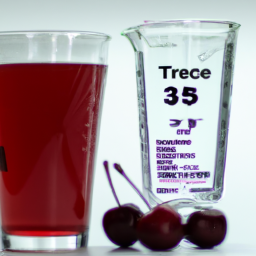As a home cook, I recognize the importance of having a reliable cutting board in the kitchen. However, there are times when even high-quality cutting boards have trouble containing the juices from fruits, vegetables, or meats. This is where the practicality of a juice groove becomes evident.
A juice groove is a channel cut into the cutting board’s surface that catches the juices, preventing them from spilling onto your countertop. In this article, I will guide you through the process of cutting a juice groove in a cutting board.
To do this, we will need a few tools and materials, including a router, a straight bit, sandpaper, and finish. We will also need a cutting board made of hardwood, such as maple or cherry.
With these items in hand, we can create a functional and aesthetically pleasing juice groove that will make our cooking experience much more enjoyable and hygienic. So let’s get started!
Key Takeaways
- A juice groove is a channel or indentation that catches spills and prevents liquids from flowing off the cutting board, improving hygiene in the kitchen.
- To cut a juice groove in a cutting board, you will need a hardwood cutting board, a router, a straight bit, sandpaper, and finish, as well as essential tools like a plunge router base, clamps, and safety gear.
- Choosing the right router bit is crucial for precise and clean cuts, and common types include straight, core box, and V-groove bits.
- Proper maintenance and care, such as regular oiling and avoiding abrasive cleaners, can help ensure that your cutting board stays in great condition for years to come.
Gather the Necessary Tools and Materials
To cut a juice groove in a cutting board, I need to gather the necessary tools and materials.
First, I need to select the right cutting board that’s thick enough to accommodate the groove.
Next, I need to choose the right router bit that’s designed for cutting grooves in wood.
Lastly, I need other essential tools, such as clamps, safety goggles, and a router guide to ensure accuracy and safety during the cutting process.
Selecting the Right Cutting Board
You’ll want to make sure that the cutting board you choose is not only durable, but also large enough to accommodate the juice groove you’ll be cutting. There are many different types of cutting board materials available, each with their own unique benefits and drawbacks. Some popular options include wood, bamboo, plastic, and composite materials.
When selecting a cutting board, consider the maintenance required to keep it in good condition. Wood and bamboo boards require regular oiling to prevent cracks and warping. Plastic boards are typically dishwasher safe, but can become scratched over time. Composite materials are often the easiest to maintain, as they are durable and dishwasher safe. To help you choose the right cutting board for your needs, refer to the table below for a comparison of popular materials.
| Cutting Board Material | Benefits | Drawbacks |
|---|---|---|
| Wood | Durable, natural appearance, gentle on knives | Requires regular oiling, can warp or crack |
| Bamboo | Sustainable, lightweight, resists bacteria | Requires regular oiling, can become brittle |
| Plastic | Dishwasher safe, affordable, resists stains | Can become scratched or damaged |
| Composite | Durable, dishwasher safe, resists bacteria | Limited appearance options |
Choosing the right cutting board is just the first step in cutting a juice groove. Next, you’ll need to select the right router bit to get the job done.
Choosing the Right Router Bit
Picking the perfect router bit is like selecting the perfect paintbrush for a masterpiece; it’s essential to achieve the desired outcome.
When it comes to cutting a juice groove in a cutting board, choosing the right router bit is crucial. There are different router bit types and sizes to choose from, and the right one will depend on the size and depth of the groove you want to create.
For instance, a straight bit is perfect for creating a shallow groove, while a core box bit will create a more rounded groove. You could also use a V-groove bit to create a decorative groove.
It’s essential to choose a bit that is at least as wide as the groove you want to create, and to adjust the depth of the bit accordingly. With the right router bit, you’ll be able to create a precise and clean juice groove that will make your cutting board both functional and beautiful.
Now, moving on to the next step, which is gathering other essential tools for the project.
Other Essential Tools
Now let’s get your workshop ready with the must-have tools for this project. To cut a juice groove in a cutting board, you’ll need a few essential tools.
These include a router, a router bit with a bearing guide, a plunge router base, clamps, and safety gear such as eye protection and earplugs. Must-have accessories for this project include a router bit with a bearing guide to help ensure that the groove is cut consistently and accurately.
A plunge router base will allow you to make precise cuts at varying depths, while clamps will help keep the cutting board securely in place during the process. Common mistakes when cutting a juice groove include not using enough clamps, not wearing safety gear, and not making the groove deep enough.
With the right tools and attention to detail, you can avoid these mistakes and create a beautiful and functional juice groove in your cutting board. Now that you have the necessary tools, let’s move on to preparing the cutting board for the groove.
Preparing the Cutting Board
Before I can start cutting a juice groove in my cutting board, I need to prepare the board first. This involves cleaning and sanding the board to ensure it’s smooth and free from any debris or rough edges.
Then, I need to mark the location of the juice groove on the board to ensure that it’s in the right spot and evenly spaced.
Cleaning and Sanding the Board
You’ll definitely want to give that board a good scrubbing and sanding to make sure it’s as smooth as a baby’s bottom before moving on to the next step. Proper maintenance is key to ensuring your cutting board lasts for years to come.
Avoiding common mistakes like using abrasive cleaners or neglecting to oil the board regularly can lead to cracking and warping over time.
Start by washing the board with hot, soapy water and a scrub brush. Rinse thoroughly and allow to dry completely.
Next, use a fine-grit sandpaper to sand the entire surface of the board, being sure to remove any rough spots or splinters.
Once the board is smooth to the touch, wipe it down with a damp cloth and allow it to dry completely before moving on to the next step – marking the location of the juice groove.
Marking the Location of the Juice Groove
To mark where the channel for collecting excess liquids will go, simply trace the outline of a small cup or bowl onto the surface of your newly cleaned and sanded wooden work surface. This will be your guide for cutting the juice groove.
Make sure to use measuring tools to ensure that the groove is consistent in width and depth. When cutting the groove, there are several cutting techniques you can use depending on the tools you have available.
A router is the most common tool used for cutting a juice groove, but a circular saw or jigsaw can also be used. It’s important to be precise with your cuts and follow the outline you traced earlier.
Once you’ve finished cutting the groove, move on to the next step of setting up the router.
Setting Up the Router
First, I need to install the router bit into the collet of the router. I’ll make sure it’s tightened securely using the wrench provided.
Then, I’ll adjust the depth of the cut based on the size of the groove I want to create. This is done by adjusting the router’s base plate up or down using the adjustment knob.
Installing the Router Bit
Once you’ve got the router bit installed, you’ll feel confident and ready to tackle the next step in creating your perfect cutting board. Before you do, take a moment to review some basic router maintenance.
Keeping your router in good condition will ensure that it works smoothly and efficiently, without causing any issues during use. Regularly clean the router bit and ensure that it’s properly tightened before use. If you’re experiencing any issues with your router, such as overheating or difficulty cutting, troubleshoot the issue before continuing with your project.
Now that your router is properly set up and maintained, it’s time to adjust the depth of the cut. This is an important step that will determine the width and depth of the juice groove.
By adjusting the depth of the cut, you can ensure that the groove is deep enough to catch any juices or liquids that may spill from your cutting board. To adjust the depth of the cut, simply adjust the height of the router bit until it reaches the desired depth.
With the depth set, you’ll be ready to start cutting your juice groove.
Adjusting the Depth of the Cut
Now that the router bit’s installed, it’s time to adjust the depth of the cut. This is crucial to ensure a precise and accurate juice groove. Before starting, I always make sure to wear eye and ear protection. Safety should always come first when working with power tools.
To adjust the depth of the cut, I first turn on the router and set it to a low speed. I then slowly lower the bit until it reaches the desired depth, making sure to do so in small increments. It’s important not to rush this process, as going too deep can ruin the entire board.
Once the depth is set, I turn off the router and double-check that everything is secure before moving on to the next step.
With the depth adjusted, it’s time to move on to cutting the juice groove.
Cutting the Juice Groove
To cut the juice groove in your cutting board, you’ll need to start by making sure you’re using the right router bit. A bit with a bearing guide is ideal, as it’ll ensure that your cuts are even and straight. Once you have the right bit, it’s important to use techniques that’ll result in a clean cut.
This means taking your time and making sure that the router is set at the correct depth. You may need to make multiple passes to achieve the desired depth, but it’s important not to rush the process. When cutting the juice groove, it’s also important to pay attention to the spacing between your cuts.
Ideally, the groove should be about 1/4 inch wide and 3/8 inch deep. To achieve this, you’ll need to make several passes with the router, moving the bit slightly closer to the board each time. Once you’ve completed the cutting process, it’s time to move on to sanding and finishing your cutting board to ensure that it’s ready for use.
Sanding and Finishing
Get the sandpaper and start smoothing out the surface of your newly routed channels, paying special attention to any rough spots or sharp edges that could cause splinters. When sanding your cutting board, use a sandpaper with a grit of 220 or higher to avoid leaving deep scratches on the surface. You can use a sanding block to ensure that you sand evenly across the cutting board.
Start sanding by moving the sandpaper in the direction of the wood grain. Don’t apply too much pressure as this can damage the surface of the cutting board. After sanding, wipe the surface of the cutting board with a clean cloth to remove any sawdust.
Applying a finish is also important to protect the cutting board from moisture and stains. You can use mineral oil, beeswax, or a combination of both to finish your cutting board.
To transition into the subsequent section about cleaning and maintaining your cutting board, it’s important to note that sanding and finishing your cutting board is not the final step in its care. Regular cleaning and maintenance are also necessary to keep your cutting board in top condition.
Cleaning and Maintaining Your Cutting Board
Keeping your cutting board in great condition requires regular cleaning and maintenance, so you can enjoy using it for years to come. One of the first things to consider is the type of material your cutting board is made of. Different materials have different benefits and drawbacks. For example, wooden cutting boards are more aesthetically pleasing and easier on knives, but require regular oiling to prevent warping and cracking. On the other hand, plastic cutting boards are easier to clean and sanitize, but can dull knives more quickly.
To properly maintain your cutting board, it is important to oil it regularly. This prevents the board from drying out, which can lead to cracks and warping. The type of oil you use is also important. Mineral oil is a common and inexpensive option, but some people prefer to use food-grade oils such as coconut oil or beeswax for a more natural option. To oil your board, simply apply a generous amount of oil to the surface and rub it in with a clean cloth. Let it sit for a few hours or overnight before wiping off any excess oil. By regularly oiling your cutting board and choosing the right material for your needs, you can ensure that it stays in top condition for years to come.
When it comes to other tips and tricks for cutting board maintenance, there are a few things to keep in mind. For example, avoid soaking your cutting board in water for extended periods of time, as this can lead to warping and cracking. Additionally, it’s a good idea to have multiple cutting boards on hand to prevent cross-contamination between different types of foods. By following these simple guidelines, you can ensure that your cutting board stays in great condition and performs well for all your cooking needs.
Other Tips and Tricks
As you prepare your meals, don’t forget to take extra steps to ensure your food stays safe and healthy to eat.
In addition to cleaning and maintaining your cutting board, you can also add a juice groove to prevent any liquids from spilling onto your countertops. Creating a juice groove is a simple process that can be done with a router or a table saw. However, if you don’t have access to these tools, you can also create a groove by using a chisel or a hand saw.
If you want to get creative with your cutting board, there are many alternative materials you can use. Bamboo, for example, is a sustainable and eco-friendly option that is also durable and easy to maintain.
Another option is using a combination of wood and resin to create a unique and colorful design. Whatever material you choose, make sure to pick one that is sturdy and non-toxic to ensure the safety of your food.
With these tips and tricks, you can make sure your cutting board not only serves its purpose but also adds a touch of style to your kitchen.
Frequently Asked Questions
Can a juice groove be added to an existing cutting board?
Yes, a juice groove can be added to an existing cutting board. Tools needed include a router, a straight bit, and a template. Step by step process involves securing the template, routing out the groove, and sanding the edges.
What is the purpose of a juice groove in a cutting board?
A cutting board with a juice groove prevents liquids from spilling over the edge and onto the countertop. It also helps to keep the work surface clean and free from bacteria. Cleaning and maintaining the groove is easy with regular washing and oiling.
How deep should a juice groove be?
When it comes to cutting board maintenance, ensuring the depth of the juice groove is correct is crucial. Choosing the right router bit is key to achieving the desired depth, typically around 1/4 inch for optimal functionality.
Can a hand saw be used instead of a router to cut a juice groove?
Using a hand saw to cut a juice groove in a cutting board is possible, but may not be as precise as using a router. Pros include affordability and portability, but cons include difficulty achieving a clean, straight cut.
Are there any safety precautions that should be taken when using a router to cut a juice groove?
When using a router, proper gear is essential for router safety. Eye protection, ear protection, and a dust mask should always be worn. Keep hands away from the bit and ensure the router is secure before use.
Conclusion
Well folks, that’s how you cut a juice groove in a cutting board! It may seem daunting at first, but with the right tools and techniques, it can be done with ease.
Remember to take your time when setting up the router and cutting the groove, as precision is key in achieving a clean and functional result. As the saying goes, "measure twice, cut once,"so don’t rush through any steps and double-check your measurements before making any cuts.
Once you’ve finished, don’t forget to sand and apply a finish to ensure the longevity of your cutting board. With proper care and maintenance, your newly grooved cutting board will be a valuable tool in your kitchen for years to come.
Happy cutting!
Ilana has been a vegan for over 10 years. She originally made the switch for health reasons, but soon found herself becoming more and more passionate about the ethical and environmental implications of a vegan lifestyle. Ilana is the author of The Graceful Kitchen, a blog all about veganism. She loves to cook up delicious and nutritious vegan meals, and share her recipes with others who are interested in leading a cruelty-free life. Ilana is also a strong advocate for using whole foods as the foundation of a healthy diet, and believes that going vegan is one of the best ways to achieve this.










